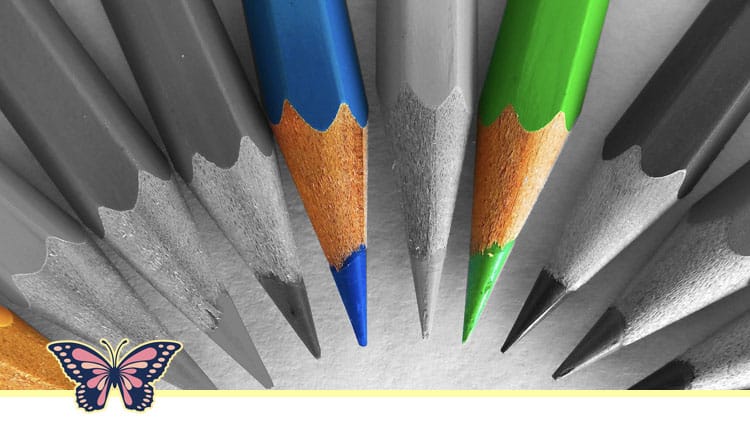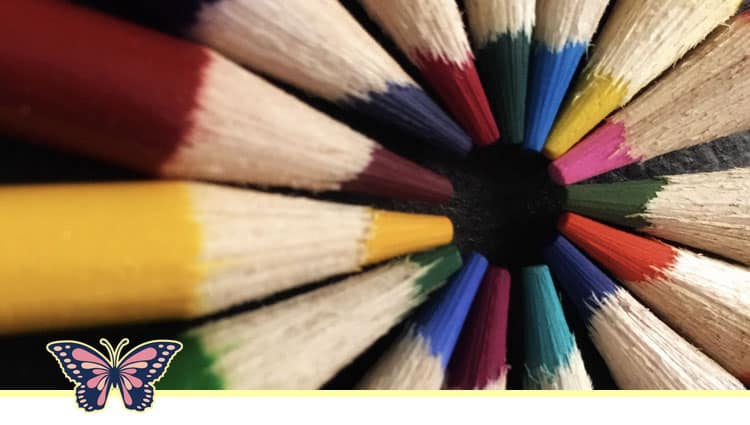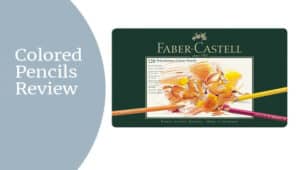
Consider the unique traits of oil-based colored pencils before buying.
Many factors go into purchasing colored pencils, and this decision is among the most important in adult coloring. In this article, I would like to share a few facts about oil-based colored pencils and provide the information as a way to collapse your learning process, save money, and help you more fully enjoy the experience and journey of adult coloring.
There is much more to buying a colored pencil than reading a review. You will spend a lot of time using colored pencils to explore and enjoy adult coloring. When I started my adult coloring journey, a colored pencil was a colored pencil. Since then, I have pondered and learned about coloring pencils, such as the difference between wax-based and oil-based colored pencils, how to use them, and the differences in their performance and use. Let’s take a closer look.
Oil-based Colored Pencils
Table of Contents
- Types of Colored Pencils
- Oil-based Colored Pencil Attributes
- Student- vs. Artist Grade Colored Pencils
- Checkout Other Articles Resources
Other resources. Check out other supporting resources on ColoringButterfly.com that you might enjoy.
- Wax-based Colored Pencils: What to Know Before You Buy
- Guide to Using Colored Pencil Set Reviews (Step-by-Step)
- Buying A Coloring Book: Everything You Need to Know (Guide)
- Buying Colored Pencils? Everything You Need Know (Guide)
- Guide to Amazon Colored Pencil Reviews (Fake vs. Trustworthy)
Types of Colored Pencils
Colored pencil leads/cores are a combination of pigment, gum binder, wax, filler (e.g., chalk or clay) and wax that is layered in a wood shaft usually made of cedar. Colored pencils usually come in wax-based or oil-based binders, and the binder determines the characteristics of the pencil’s performance and capabilities. Manufacturers create different recipes for student-grade and artist-grade colored pencils. Colored pencils come in three different types. [TOC]
Oil-based colored Pencils
Oil-based colored pencils are medium soft compared to wax-based pencils and last longer. The core pigment consists of a vegetable-based binder that holds the pigment together and is resistant to water. Oil-based pencils require a little more pressure to get the same coverage obtained with wax-based colored pencils. Oil-based pencils do not blend or layer as quickly as wax-based pencils. The firmer core also means that the lead is less like to break. One of the drawbacks to oil-based pencils is that they are prone to smearing and harder to erase. [TOC]
Wax-based Colored Pencils
Wax-based colored pencils are the softest pencil, provide full coverage and exhibit intense color. The core pigment is held together with a wax binder, and the right amount of wax gives the pencil a smooth texture and helps the pigment glide across the paper. They are known for their ability to blend and layer easily. Because of the softness, their core is more prone to break than other pencils. A common feature of wax-based colored pencils is wax blooms during layering. This white, milky-like glaze occurs as the wax binder rises through the pigment and settles on the paper’s surface. [TOC]
Water-Soluble Colored Pencils
Water-soluble colored pencils are often referred to as watercolor pencils and can be used to create watercolor effects without water for drawings. The core contains an Arabic bind activated by water, so the pigment blends when water is added. [TOC]
Oil-based Colored Pencil Attributes

I remember when I bought my first set of colored pencils. I was clueless in my research. I reviewed up to 10 pencil brands, read five or more reviews for each, and viewed many Amazon reviews. The more I looked, the more I hesitated and confused I felt. I ended up buying a cheap brand with lots of colors. That was a terrible choice. I wanted to quit coloring because I was not too fond of the pencil set and the coloring experience they gave me. I did not know there was a difference in pencils. The following are a few of the considerations to look for and evaluate with oil-based colored pencils:
Oil-based Colored Pencil Cores
Oil-based cores contain varying amounts of pigments, additives, and binding agents. The following are a few characteristics of oil-based colored pencil cores.
- More pigment. Oil-based pencils have more pigment and lay down with vibrant colors. The intensity of colors is richer and deeper with fewer layers.
- Application. Oil-based colored pencils lay down vibrant colors.

- Harder than the wax-based core. The hardcore pencils last longer, are known to be more durable and are less susceptible to breakage
- Layering. Oil-based can layer easily, and the core will lay down less color when applied to the paper but can give the user more control of color. Using pencils and solvents (e.g., Gamsol, Zest-it) helps to eliminate pencil strokes and make the colors smoother and more uniform.
- Softcore Layering. If the oil-based colored pencil has a softcore, you experience better layering than you would with a wax-based core.
- No blooming. Unlike wax-based pencils that can account for a bloom with layering, oil-based pencils will not bloom.
- Less susceptible to breakage. The harder core makes them less susceptible to breakage.
- Less erasable. Oil-based cores are not as easy to erase as wax-based colored pencils.
- Sharpening. Because of the core hardness, they are less prone to breakage during sharpening, and you can achieve a sharper point.
- Lightfastness. Many oil-based pencils come with a lightfastness rating. Lightfastness is a property of a colorant such as dye or pigment that describes how resistant to fading it is when exposed to light. Lightfast rating is essential to artists, especially when they spend long hours creating art; they will want the work of art to keep its vibrancy for years to come.
- Detail. Because pencils can be sharpened to a fine point, they are great for detail.
- Less set options. Manufacturers tend to have fewer set options.
- Higher price point. Oil-based pencils usually come with higher costs, such as those detailed above. Because of their hardness and overall characteristics, the pencils last longer.
- Example of an excellent oil-based colored pencil. Today, there is a plethora of good oil-based colored pencils in all price ranges. The most common oil-based core that many colorists have in their collection/resources is Faber Castell colored pencils. [TOC]
Pigment Quality
Colored pencil sets range vastly from student grade to professional grade. The pigment will be the most significant difference contributing to quality and price. More pigment means your colors will look fresh and vibrant or longer. When I test/review pigment, I look at elements like
- Vibrancy. Pigment concentration is the most significant contributing factor to color vibrancy. For example,
 some colored pencil sets require more layers and heavier strokes to achieve color brightness/depth, while others achieve the same lively colors with gentler/softer strokes.
some colored pencil sets require more layers and heavier strokes to achieve color brightness/depth, while others achieve the same lively colors with gentler/softer strokes.
- Application experience. I reviewed the experience I had when applying each stroke of color. Was the application of color smooth, creamy, scratchy or other?
- Response to types of coloring paper. I want to understand how the color looks when each stroke is applied to coloring book paper (e.g., Amazon-like to artist edition) during layering and blending without the aid of other substances (e.g., Blender Pencils, mineral spirits).
- Basic layering/blending. I look at how the pigment responded to layering and blending without assistance from tools (e.g., blender pencils, white pencils, Gamsol/Zest-it).
- Blending with pencils, solvents and more. I review how the pigment responds/breaks down to blender pencils (e.g., Prismacolor and Derwent blender pencils), burnishing, white pencils, blending stumps, solvents (e.g., Gamsol, Zest-it), blender pens and more.
- Comparison to similar categories. I review how the pigment compares to the categorization of the pencil (e.g., student grade, artist/professional grade). Artist-grade categorization usually means higher quality, and I expect the colors to be vibrant with each stroke. Another way to look at it is the price range (e.g., budget, average, expensive) category.
- Overall category comparison. I also look outside the category and see how the pigment/pencil compares to all other colored pencil brands, regardless of category classification. [TOC]
Color Variety
I carefully evaluate the variety of colors presented in the set. For example, an artist has the skill to take just a few colors and blend them into many more colors. Because I am focused on coloring books, I want to have the necessary colors to address my favorite coloring book themes. Since I am reviewing pencil sets on a broad base, I ask myself questions like
- Does the pencil set have a good breath of color?
- Does the colored pencil set have a range of colors to address any coloring book theme (e.g., jungle, deserts, people, shapes, mandalas, flowers, animals, and mythical variations)? If not, what then?
- Do the pencil sets have too many of one color or not enough of another? [TOC]
Colored Pencil Construction
Pencil cores combine pigment, gum binder, wax or oil and filler material encased in wood. The pencil construction can tell you a lot about the quality of the pencil. All colored pencils are not made equal. When evaluating a pencil, these are a few of the construction elements I look for:
- Colored Pencil Cores. The most common colored pencil cores are either wax-based or oil-based. Pencil cores combine pigment, gum binder, wax or oil and filler.
- Pigments. The pigment will be the most significant difference contributing to quality and price, and pigment concentration is the most significant factor in color vibrancy. For example, some colored pencil sets require more layers and heavier strokes to achieve color brightness/depth, while others achieve the same lively colors with gentler/softer strokes.
-
- Binders. Binders/resins are property that binds/clues the pigment when mixed. Binders can range from paraffin wax to oily compounds. Binders significantly affect how colored pencil performs/interacts on varying types of paper.
-
- Extenders. Extenders and binders define the core’s firmness, and Extenders have a bearing on whether the colored pencil feels creamy and soft or firm and ridged.
Every manufacturer has their own formula/recipe for their colored pencils. Many manufacturers will have different types of pencil sets in their brand to address the needs of different coloring needs, price points, and types of artists/colorists. For example, Derwent has the following brands in its offerings: Derwent Couloursoft Pencils, Derwent Lightfast Colour Pencils, Derwent Procolour Pencils, and Derwent Studio Colored Pencils. When evaluating cores, it is important to understand the type of characteristics the wax-based and oil-based provide for the coloring experience. When you read reviews, look closely at how the core performs with coloring, sharpening, and related tasks.
- Core/Lead Size. Most colored pencils have a core diameter between 3mm and 4mm. The large core diameter will contribute to how long the pencil will last.
- Wood. Wood is used to encase the colored pencil core, and higher quality pencil casings are Cedarwood. Be on the lookout for words like “compressed wood.” Better quality woods are less likely to break with dropped or during sharpening. The wood quality can make all the difference in the pencil experience. When you read reviews, look closely at how the wood performs with coloring, sharpening, and related tasks.
- Round vs. hexagon pencil barrel. When it comes to round vs. hexagonal colored pencil barrel designs, there are pros and cons for each design. The round pencil barrels tend to roll when placed on uneven surfaces when bumped on a surface and can fall on the floor and break the lead. The hexagonal pencil, however, will stay in place without rolling.
I like the round barrels because they feel comfortable in my hands. When I use colored pencils, I will select the two or three colors I am working with and keep them out of the plastic tray or pencil case for easy access. My simple solution is to place the pencils in a temporary secure place (e.g., mug, small plastic tray, inside of the open case, inside tin lid of a pencil case). [TOC]
Performance with Paper
Colored pencils will respond differently to various types of paper, and I want to understand how the pencils perform with different types of paper. When I color, I like to match the pencil to the paper. Many colored pencils work well on all papers. Coloring books are usually not known for having quality paper. I want to ensure that the pencils I use will work well with the coloring books I am using. For example, a more textured paper will wear down a tip faster but will hold more layers. In contrast, a smoother paper will save on the lead but will not hold as many layers. [TOC]
Student- vs. Artist Grade Colored Pencils

There are many choices, and the choices are based on many factors that range in core pigment, color vibrancy, hardness vs. softness, wax vs. oil, performance, cost and more. Let’s take a quick look at some differences between student-grade and artist-grade-colored pencils. There are wax-based pencils in both student- and artist-grade-colored pencils. Here a just a few of the differences.
Student-Grade Colored Pencils
I expect the pencil core to be harder if it is a student-grade pencil. The formula for the core has more bonding agents than pigment, and colors will be less vibrant and fade over time. Student grade is used for learning colored pencil skills, and you will need to apply more pressure for better saturation. Rarely will you find student-grade pencils that have a lightfast rating. They are easier to erase, which helps in making corrections/adjustments. These are excellent starting points for beginners. Pencils in the category can include budget and mid-range pricing.
- The budget range of colored pencils would be brands like Zenacolor, Star-Joy, Soucolor, and Markart.
- The low-moderate to moderate-expensive would include pencils brands like Prismacolor Premier, Derwent Procolour, Castle Art Supplies, Arteza Expert, and Black Widow. [TOC]
Artist-Grade/Professional Colored Pencils
Artist-grade pencils are usually oil-based and are more expensive. They are known for quality pigments, performance, and lightfast ratings are known for quality pigment. They are more fade-resistant and can be sharpened to a fine point. If they are softcore, they are great for blending, layering, and shading. This grade of a pencil will often have a lightfast rating which is the property of a colorant such as dye or pigment that describes how resistant to fading it is when exposed to light. Pencils in this category would be Caran D’Ache Pablos, Farber-Castell Polychromos, Derwent Lightfast, Caran D’Ache Luminance, and Holbein. [TOC]
If you like this article, please share it with others.






